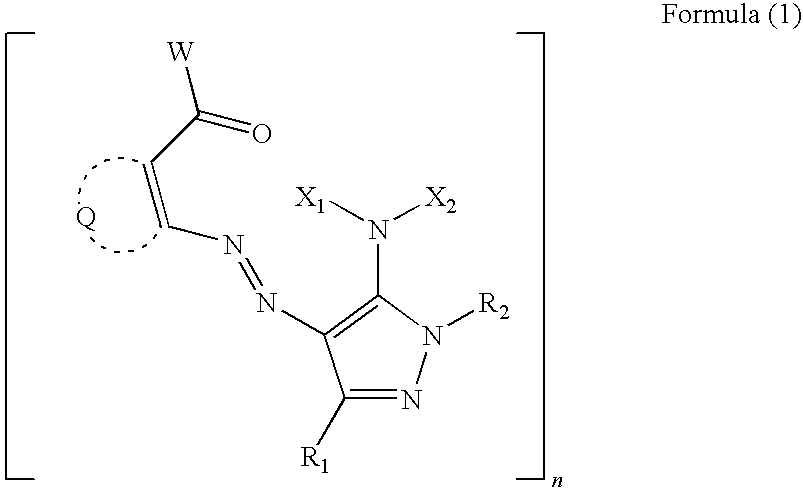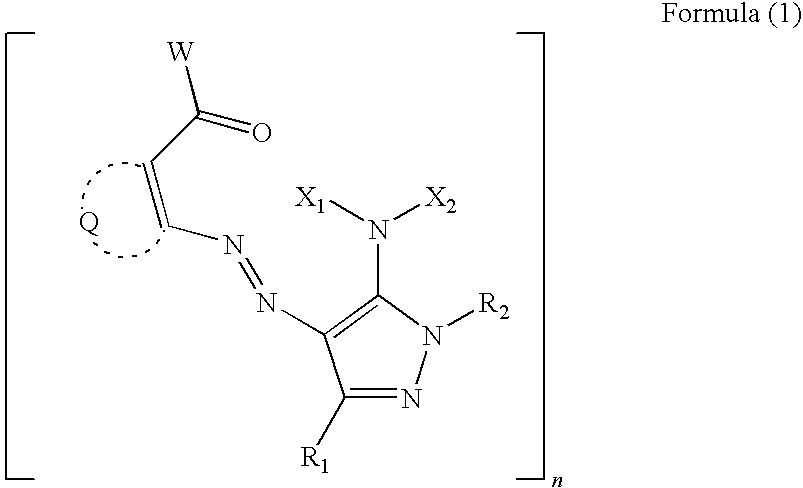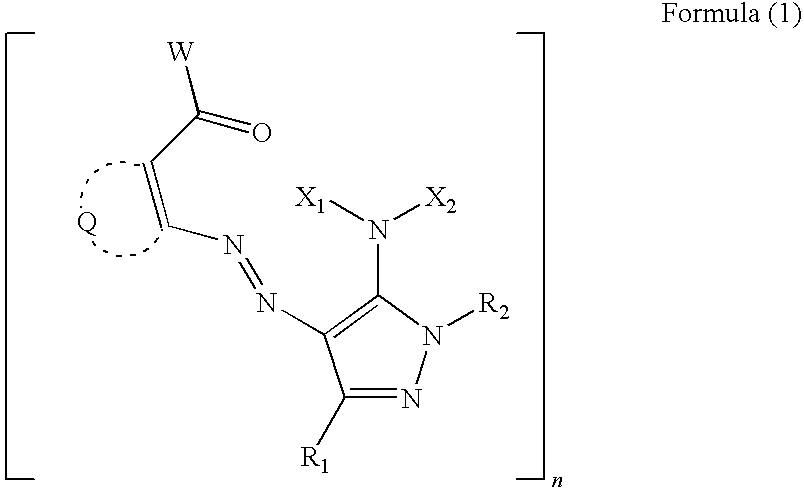Water-based ink composition for inkjet recording
a technology of water-based ink and inkjet recording, which is applied in the direction of application, disazo dye, trisazo dye, etc., can solve the problem of unsatisfactory level and achieve the effect of excellent discharge stability
- Summary
- Abstract
- Description
- Claims
- Application Information
AI Technical Summary
Benefits of technology
Problems solved by technology
Method used
Image
Examples
synthesis example 1
[0353]Synthesis of Exemplified Compound (Pig.-1)
[0354]The synthetic scheme of the exemplified compound (Pig.-1) is shown below.
[0355](1) Synthesis of Intermediate (a)
[0356]42.4 g (0.4 mol) of trimethyl orthoformate, 20.4 g (0.2 mol) of acetic anhydride, and 0.5 g of p-toluenesulfonic acid were added to 29.7 g (0.3 mol) of methyl cyanoacetate, which was heated at 110° C. (outside temperature) and then stirred for 20 hours while a low-boiling-point component formed from the reaction system was distilled away. The reaction liquid was concentrated under reduced pressure. Thereafter, the resulting product was purified on a silica gel column, and 14.1 g of the intermediate (a) (yellow powder, yield: 30%) was obtained. The results of NMR measurement of the obtained intermediate (a) are shown below.
[0357]1H-NMR(300 MHz, CDCl3) 7.96(s,1H), 4.15(s,3H), 3.81(s,3H)
[0358](2) Synthesis of Intermediate (b)
[0359]150 mL of i-propanol was added to 7.4 mL (141 mmol) of methylhydrazine, which was coole...
synthesis example 2
[0372]—Synthesis of Styrene-Acrylic Acid Copolymer—
[0373]The components having the following monomer composition were mixed so that the whole content of monomer components was 100 parts by mass. As a polymerization initiator, 1 part by mass of 2,2′-azobis(2,4-dimethylvaleronitrile) was added thereto. Then, the nitrogen gas replacement was sufficiently carried out and a synthetic mixture was obtained.
Styrene45 parts by massAcrylic acid10 parts by massMethacrylic acid10 parts by massMethyl methacrylate35 parts by mass2-mercaptoethanol0.1 part by mass
[0374]Subsequently, while 100 parts by mass of methyl ethyl ketone was stirred under nitrogen atmosphere, the temperature was increased to 75° C. While the compound was stirred at 75° C., the synthetic mixture was added dropwise into the compound over 2 hours. Further, the reaction was continued while the mixture was stirred at 75° C. for 4 hours. Then, the synthetic compound was naturally cooled to 25° C. Thereafter, methyl ethyl ketone...
synthesis example 3
[0377]—Preparation of Self-Dispersing Fine Polymer Particles—
[0378]350.0 g of methyl ethyl ketone was placed in a 2 L three-necked flask equipped with a stirrer, a thermometer, a reflux condenser, and a nitrogen gas introducing tube, which was heated to 75° C. While the inside temperature of the reaction vessel was kept at 75° C., a mixed solution of 162.0 g of phenoxyethyl acrylate, 180.0 g of methyl methacrylate, 18.0 g of acrylic acid, 70 g of methyl ethyl ketone, and 1.44 g of V-601 (trade name; manufactured by Wako Pure Chemical Industries, Ltd.) was added dropwise at a constant speed so as to complete the dropping within 2 hours. After the dropping, a solution of 0.72 g of “V-601” and 36.0 g of methyl ethyl ketone was added thereto, which was stirred at 75° C. for 2 hours.
[0379]A solution of 0.72 g of “V-601” and 36.0 g of i-propanol was added to the resulting mixture, which was stirred at 75° C. for 2 hours, then heated to 85° C., and further stirred for 2 hours. The weight a...
PUM
| Property | Measurement | Unit |
|---|---|---|
| Percent by mass | aaaaa | aaaaa |
| Percent by mass | aaaaa | aaaaa |
| Percent by mass | aaaaa | aaaaa |
Abstract
Description
Claims
Application Information
 Login to View More
Login to View More - R&D
- Intellectual Property
- Life Sciences
- Materials
- Tech Scout
- Unparalleled Data Quality
- Higher Quality Content
- 60% Fewer Hallucinations
Browse by: Latest US Patents, China's latest patents, Technical Efficacy Thesaurus, Application Domain, Technology Topic, Popular Technical Reports.
© 2025 PatSnap. All rights reserved.Legal|Privacy policy|Modern Slavery Act Transparency Statement|Sitemap|About US| Contact US: help@patsnap.com



